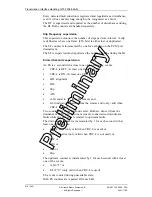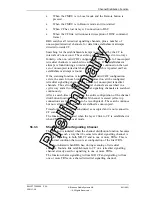
Transmission Interface Handling DS1 1544 kbit/s
4.
Neither PCM-A nor B can be used as reference source
The free running oscillator is selected as reference source
The free running oscillator is used to synchronize both PCM-A
and B outgoing.
The default setting of PCM-A and PCM-B is:
PCM-A: “Available for synchronization”
PCM-B: “Not available for synchronization”.
The parameters can be modified from OMT. The new setting is
activated immediately. Thus, the updated parameters are used when the
selection of synchronization source is performed.
54.3.3
Supervision of Transmission Faults
The supervision is initiated during restart of DXU.
Fault supervision of each PCM line is performed according to:
•
ANSI T1.403, section 8
•
AT&T T1.5 SERVICE, paragraph 7
The configuration of fault supervision can only be performed when the
AO DP (Digital Path) is in state ”Disable”. The reporting to the BSC is
performed when the AO DP is in state “Enable”. When the AO DP is
enabled, all fault supervision states are set to zero.
Reports are sent to the BSC when the alarm status is changed or when
required from the BSC.
The fault supervision includes detection and reporting of the following
fault conditions:
•
LOF (Loss of Frame Alignment)
•
ERATE (Exessive Error RATE)
•
LOS (Loss Of incoming Signal)
•
AIS (Alarm Indication Signal),”Blue Alarm”
•
RAI (Remote Alarm Indication), “Yellow Alarm”
•
UAST (UnAvailable STate supervision). Consists of two
directions; upstream and downstream.
Fault handling is according to Diagnostic and Fault Handling
functionality.
LOS commences
At least 31 successive pulse positions with no pulses of either positive
or negative polarity have occurred.
LOS ceases
Recovery of frame alignment signal.
EN/LZT 720 0008
P2A
2001-11-28
427 (485)
© Ericsson Radio Systems AB
— All Rights Reserved —
P
re
li
m
in
a
ry
Summary of Contents for RBS 2106
Page 2: ...P r e l i m i n a r y ...
















































